Using Heat as a Tracer to Detect the Development of the Recharge Bulb in Managed Aquifer Recharge Schemes
Abstract
1. Introduction
2. Materials and Methods
2.1. Study Site
2.2. The LIFE REWAT Managed Aquifer Recharge Scheme
2.3. Groundwater Head and Temperature Monitoring
3. Results and Discussion
4. Conclusions
Supplementary Materials
Author Contributions
Funding
Acknowledgments
Conflicts of Interest
References
- Arnell, N.W. Climate change and global water resources. Glob. Environ. Chang. 1999, 9, S31–S49. [Google Scholar] [CrossRef]
- European Environment Agency. Water Use and Environmental Pressures. 2020. Available online: https://www.eea.europa.eu/themes/water/european-waters/water-use-and-environmental-pressures/water-use-and-environmental-pressures (accessed on 30 December 2020).
- Leduc, C.; Pulido-Bosch, A.; Remini, B. Anthropization of groundwater resources in the Mediterranean region: Processes and challenges. Hydrogeol. J. 2017, 25, 1529–1547. [Google Scholar] [CrossRef]
- Dillon, P. Future management of aquifer recharge. Hydrogeol. J. 2005, 13, 313–316. [Google Scholar] [CrossRef]
- Dillon, P.; Stuyfzand, P.; Grischek, T.; Lluria, M.; Pyne, R.D.G.; Jain, R.C.; Bear, J.; Schwarz, J.; Wang, W.; Fernandez, E.; et al. Sixty years of global progress in managed aquifer recharge. Hydrogeol. J. 2019, 27, 1–30. [Google Scholar] [CrossRef]
- Wintgens, T.; Hochstrat, R.; Kazner, C.; Jeffrey, P.; Jefferson, B.; Melin, T. Managed Aquifer Recharge as a Component of Sustainable Water Strategies-A Brief Guidance for EU Policies. In Water Reclamation Technologies for Safe Managed Aquifer Recharge; IWA Publishing: London, UK, 2012; pp. 411–429. [Google Scholar]
- Fernandez Escalante, E.; Henao Casas, J.D.; Vidal Medeiros, A.M.; San Sebastián Sauto, J. Regulations and guidelines on water quality requirements for Managed Aquifer Recharge. International comparison. Acque Sotter. Ital. J. Groundw. 2020, 9, 7–22. [Google Scholar] [CrossRef]
- Prathapar, S.; Dhar, S.; Rao, G.T.; Maheshwari, B. Performance and impacts of managed aquifer recharge interventions for agricultural water security: A framework for evaluation. Agric. Water Manag. 2015, 159, 165–175. [Google Scholar] [CrossRef]
- Maliva, R.G. Managed aquifer recharge: State-of-the-art and opportunities. Water Sci. Technol. Water Supply 2015, 15, 578–588. [Google Scholar] [CrossRef]
- Bundschuh, J.; Sracek, O. Introduction to Groundwater Geochemistry and Fundamentals of Hydrogeochemical Modelling; Taylor & Francis Group: Abingdon, UK, 2012. [Google Scholar]
- Ganot, Y.; Holtzman, R.; Weisbrod, N.; Nitzan, I.; Katz, Y.; Kurtzman, D. Monitoring and modeling infiltration-recharge dynamics of managed aquifer recharge with desalinated seawater. Hydrol. Earth Syst. Sci. 2017, 21, 4479–4493. [Google Scholar] [CrossRef]
- Rossetto, R.; Barbagli, A.; De Filippis, G.; Marchina, C.; Vienken, T.; Mazzanti, G. Importance of the Induced Recharge Term in Riverbank Filtration: Hydrodynamics, Hydrochemical, and Numerical Modelling Investigations. Hydrology 2020, 7, 96. [Google Scholar] [CrossRef]
- Rossetto, R.; Barbagli, A.; Borsi, I.; Mazzanti, G.; Vienken, T.; Bonari, E. Site investigation and design of the monitoring system at the Sant’Alessio Induced RiverBank Filtration plant (Lucca, Italy). Rend. Online Soc. Geol. Ital. 2015, 35, 248–251. [Google Scholar] [CrossRef]
- Mawer, C.; Kitanidis, P.; Pidlisecky, A.; Knight, R. Electrical resistivity for characterization and infiltration monitoring beneath a managed aquifer recharge pond. Vadose Zone J. 2013, 12, vzj2011.0203. [Google Scholar] [CrossRef]
- Nenna, V.; Pidlisecky, A.; Knight, R. Monitoring managed aquifer recharge with electrical resistivity probes. Interpretation 2014, 2, T155–T166. [Google Scholar] [CrossRef]
- Haaken, K.; Furman, A.; Weisbrod, N.; Kemna, A. Time-Lapse Electrical Imaging of Water Infiltration in the Context of Soil Aquifer Treatment. Vadose Zone J. 2016, 15, 1–12. [Google Scholar] [CrossRef]
- García-Menéndez, O.; Ballesteros, B.J.; Renau-Pruñonosa, A.; Morell, I.; Mochales, T.; Ibarra, P.I.; Rubio, F.M. Using electrical resistivity tomography to assess the effectiveness of managed aquifer recharge in a salinized coastal aquifer. Environ. Monit. Assess. 2018, 190, 100. [Google Scholar] [CrossRef]
- Davis, K.; Li, Y.; Batzle, M. Time-lapse gravity monitoring: A systematic 4D approach with application to aquifer storage and recovery. Geophysics 2008, 73, WA61–WA69. [Google Scholar] [CrossRef]
- Chapman, D.S.; Sahm, E.; Gettings, P. Monitoring aquifer recharge using repeated high-precision gravity measurements: A pilot study in South Weber, Utah. Geophysics 2008, 73, WA83–WA93. [Google Scholar] [CrossRef][Green Version]
- Anderson, M.P. Heat as a ground water tracer. Groundwater 2005, 43, 951–968. [Google Scholar] [CrossRef]
- Banks, D. From Fourier to Darcy, from Carslaw to Theis: The analogies between the subsurface behaviour of water and heat. Acque Sotter. Ital. J. Groundw. 2012, 1, 3. [Google Scholar] [CrossRef][Green Version]
- Becker, M.W.; Bauer, B.; Hutchinson, A. Measuring artificial recharge with fiber optic distributed temperature sensing. Groundwater 2013, 51, 670–678. [Google Scholar] [CrossRef]
- Mawer, C.; Parsekian, A.; Pidlisecky, A.; Knight, R. Characterizing heterogeneity in infiltration rates during managed aquifer recharge. Groundwater 2016, 54, 818–829. [Google Scholar] [CrossRef]
- Racz, A.J.; Fisher, A.T.; Schmidt, C.M.; Lockwood, B.S.; Huertos, M.L. Spatial and temporal infiltration dynamics during managed aquifer recharge. Groundwater 2012, 50, 562–570. [Google Scholar] [CrossRef]
- des Tombe, B.F.; Bakker, M.; Schaars, F.; van der Made, K.J. Estimating travel time in bank filtration systems from a numerical model based on DTS measurements. Groundwater 2018, 56, 288–299. [Google Scholar] [CrossRef]
- Kurylyk, B.L.; Irvine, D.J.; Carey, S.K.; Briggs, M.A.; Werkema, D.D.; Bonham, M. Heat as a groundwater tracer in shallow and deep heterogeneous media: Analytical solution, spreadsheet tool, and field applications. Hydrol. Processes 2017, 31, 2648–2661. [Google Scholar] [CrossRef]
- Rossetto, R.; De Filippis, G.; Borsi, I.; Foglia, L.; Cannata, M.; Criollo, R.; Vázquez-Suñé, E. Integrating free and open source tools and distributed modelling codes in GIS environment for data-based groundwater management. Environ. Model. Softw. 2018, 107, 210–230. [Google Scholar] [CrossRef]
- Barazzuoli, P.; Bouzelboudjen, M.; Cucini, S.; Király, L.; Menicori, P.; Salleolini, M. Olocenic alluvial aquifer of the River Cornia coastal plain (southern Tuscany, Italy): Database design for groundwater management. Environ. Geol. 1999, 39, 123–143. [Google Scholar] [CrossRef]
- Celati, R.; Grassi, S.; D’Amore, F.; Marcolini, L. The low temperature hydrothermal system of Campiglia, Tuscany (Italy): A geochemical approach. Geothermics 1991, 20, 67–81. [Google Scholar] [CrossRef]
- PASI. Portable Groundwater Level Meter. Freatimetro. 2021. Available online: https://www.pndshop.it/dt/ct20183/art201821/freatimetro-bfk (accessed on 10 December 2021).
- PASI. Portable Groundwater Level and Thermo Meter. Termofreatimetro. 2021. Available online: https://www.pndshop.it/dt/ct20183/art201823/freatimetro-wmf-02 (accessed on 10 December 2021).
- QGIS Development Team. QGIS Geographic Information System. Open Source Geospatial Foundation Project. 2021. Available online: http://qgis.osgeo.org (accessed on 11 December 2021).
- Servizio Idrologico e Geologico della Regione Toscana. Settore Idrologico e Geologico Regionale. DATI Termometria. 2021. Available online: https://www.sir.toscana.it/termometria-pub (accessed on 10 December 2021).
- Servizio Idrologico e Geologico della Regione Toscana. Settore Idrologico e Geologico Regionale. DATI Idrometria. 2021. Available online: https://www.sir.toscana.it/idrometria-pub (accessed on 10 December 2021).
- Servizio Idrologico e Geologico della Regione Toscana. Settore Idrologico e Geologico Regionale. DATI Pluviometria. 2021. Available online: https://www.sir.toscana.it/pluviometria-pub (accessed on 10 December 2021).
- Chesnaux, R. Avoiding confusion between pressure front pulse displacement and groundwater displacement: Illustration with the pumping test in a confined aquifer. Hydrol. Processes 2018, 32, 3689–3694. [Google Scholar] [CrossRef]
- Verseveld, W.J.V.; Barnard, H.R.; Graham, C.B.; McDonnell, J.J.; Brooks, J.R.; Weiler, M. A sprinkling experiment to quantify celerity–velocity differences at the hillslope scale. Hydrol. Earth Syst. Sci. 2017, 21, 5891–5910. [Google Scholar] [CrossRef] [PubMed]
- Worthington, S.R.; Foley, A.E. Deriving celerity from monitoring data in carbonate aquifers. J. Hydrol. 2021, 598, 126451. [Google Scholar] [CrossRef]
- Giambastiani, B.M.S.; Colombani, N.; Mastrocicco, M. Limitation of using heat as a groundwater tracer to define aquifer properties: Experiment in a large tank model. Environ. Earth Sci. 2012, 70, 719–728. [Google Scholar] [CrossRef]
- Barbagli, A.; Jensen, B.N.; Raza, M.; Schueth, C.; Rossetto, R. Assessment of soil buffer capacity on nutrients and pharmaceuticals in nature-based solution applications. Environ. Sci. Pollut. Res. 2019, 26, 759–774. [Google Scholar] [CrossRef]
- NRMMC; EPHC; NHMRC. Australian Guidelines for Water Recycling, Managing Health and Environmental Risks, Vol 2C: Managed Aquifer Recharge; Natural Resource Management Ministerial Council, Environment Protection and Heritage Council National Health and Medical Research Council: Australia, 2009; 237 p. Available online: http://www.environment.gov.au/water/publications/quality/water-recycling-guidelines-mar-24.html (accessed on 8 January 2022).
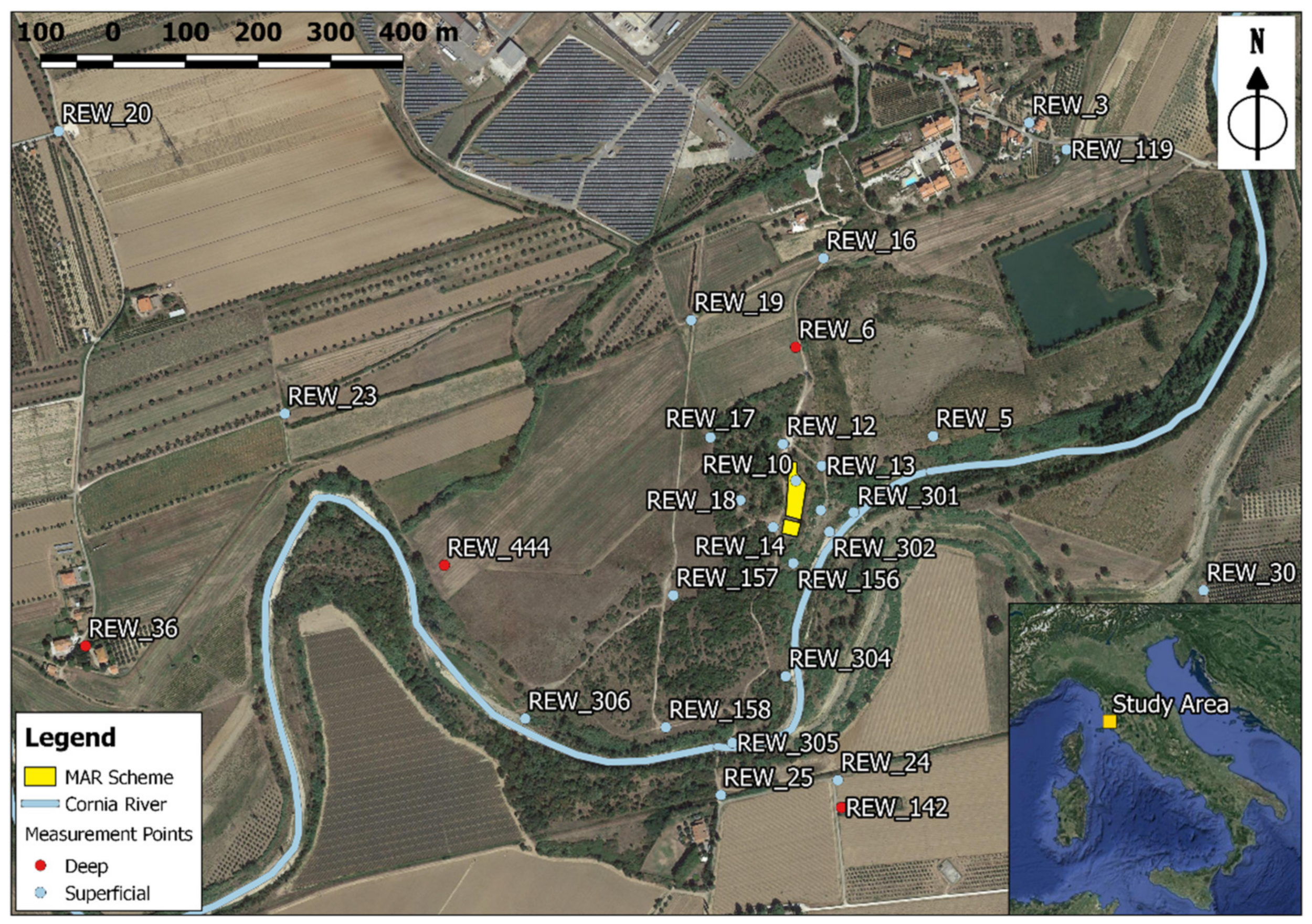
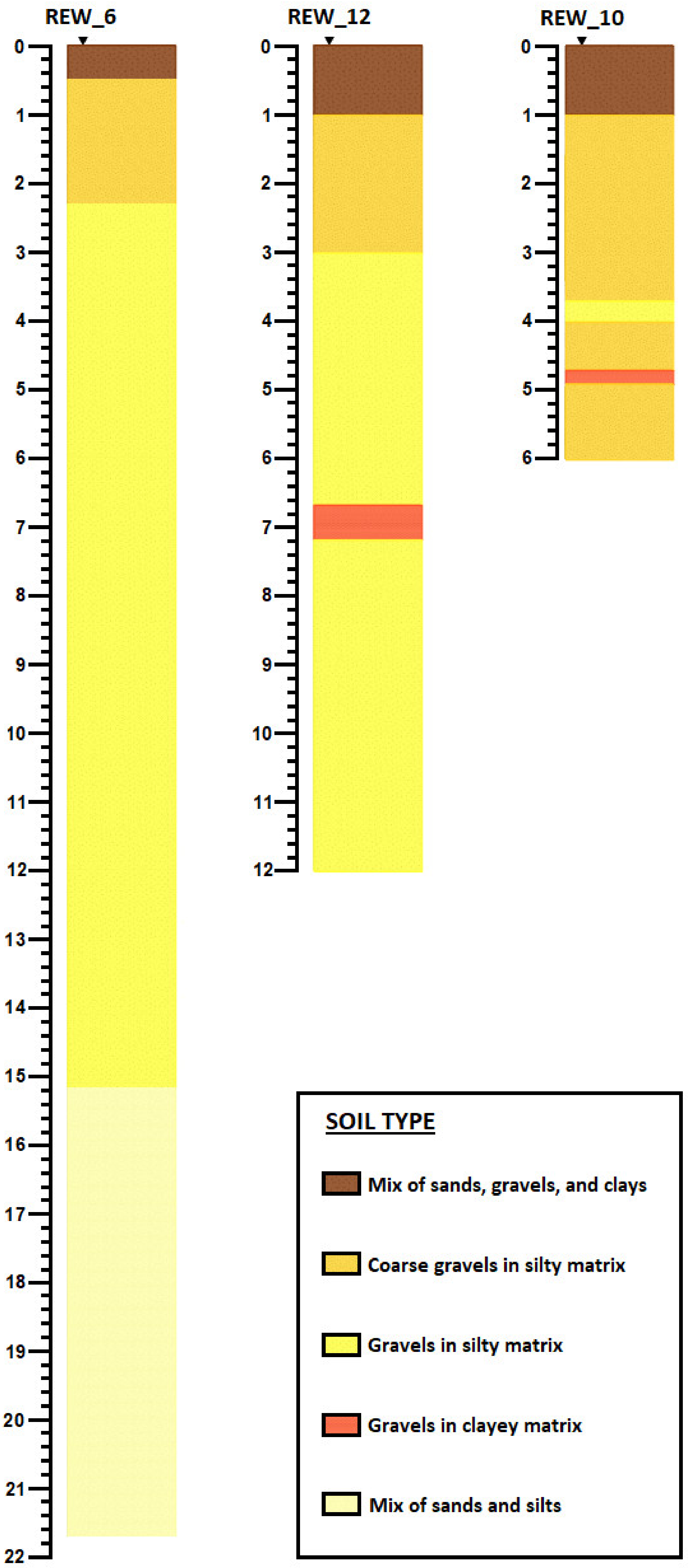
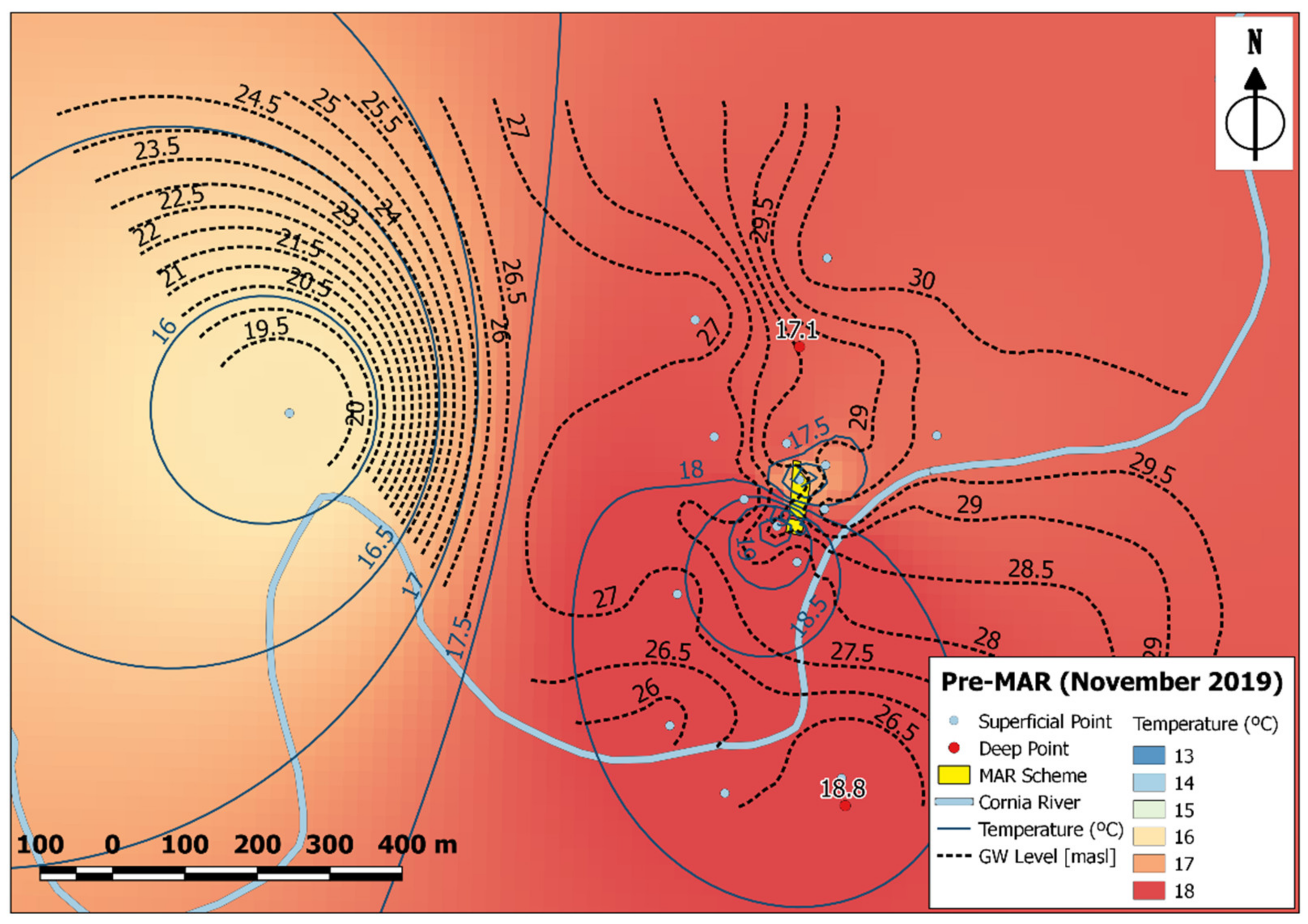
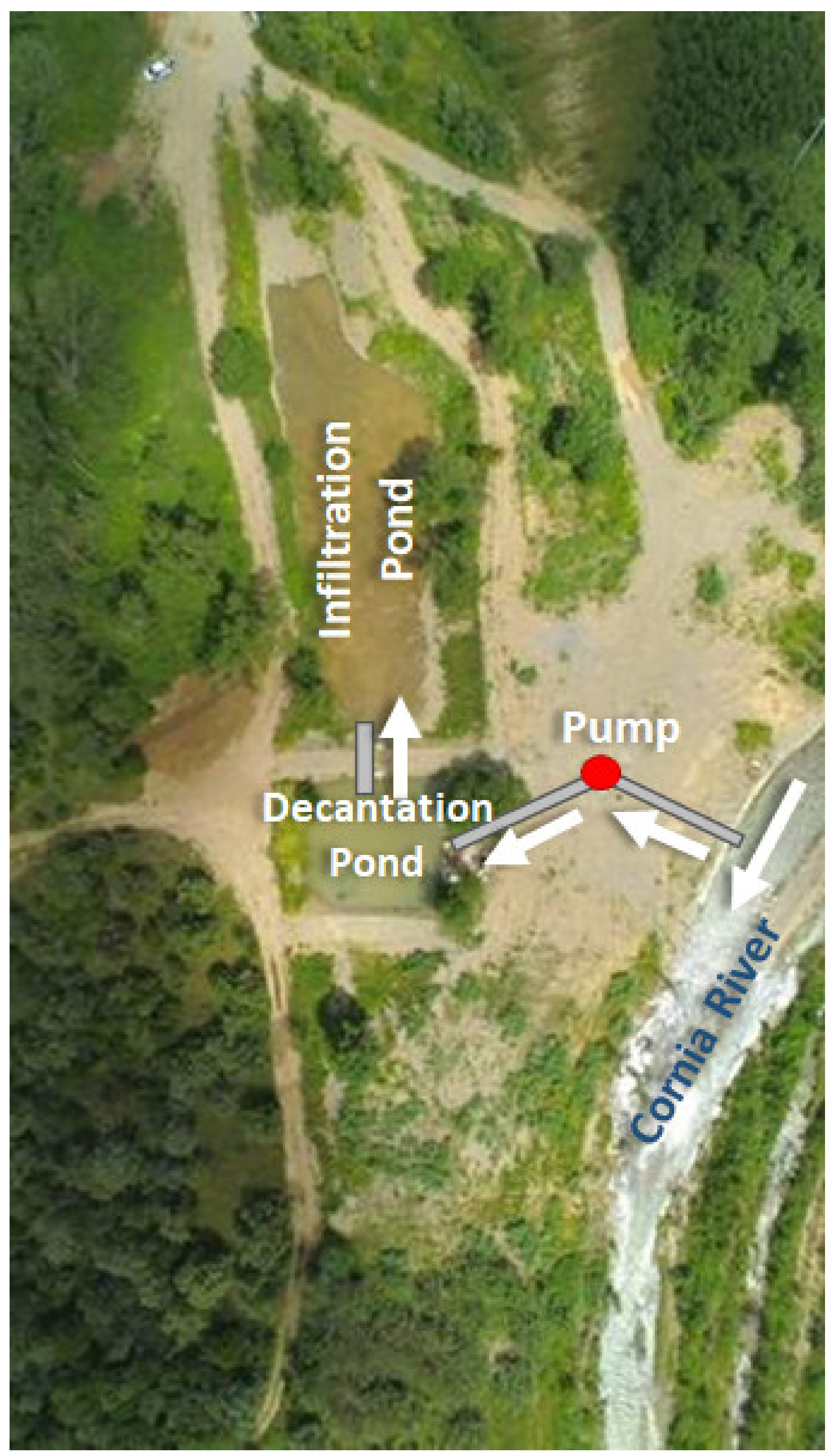
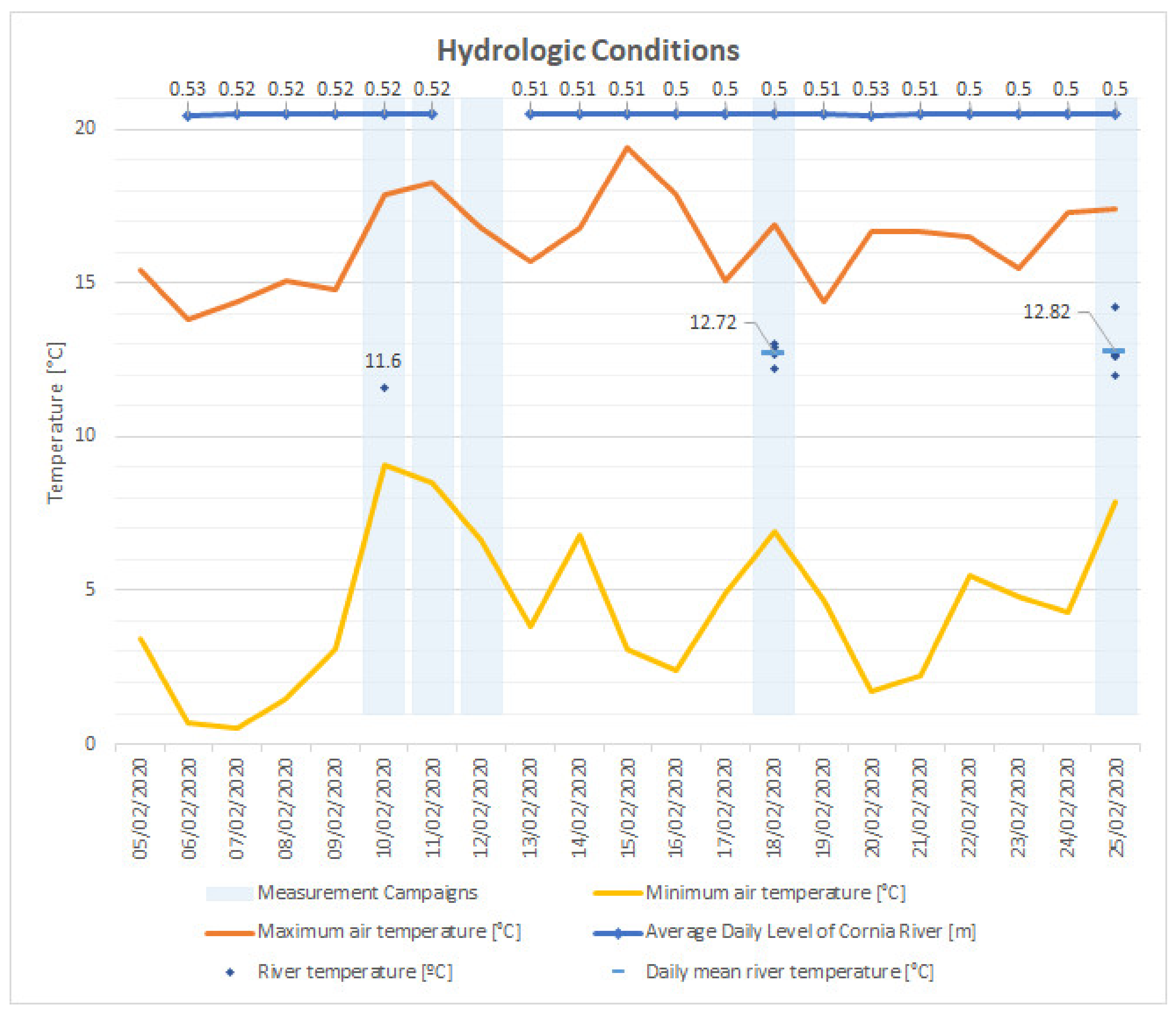

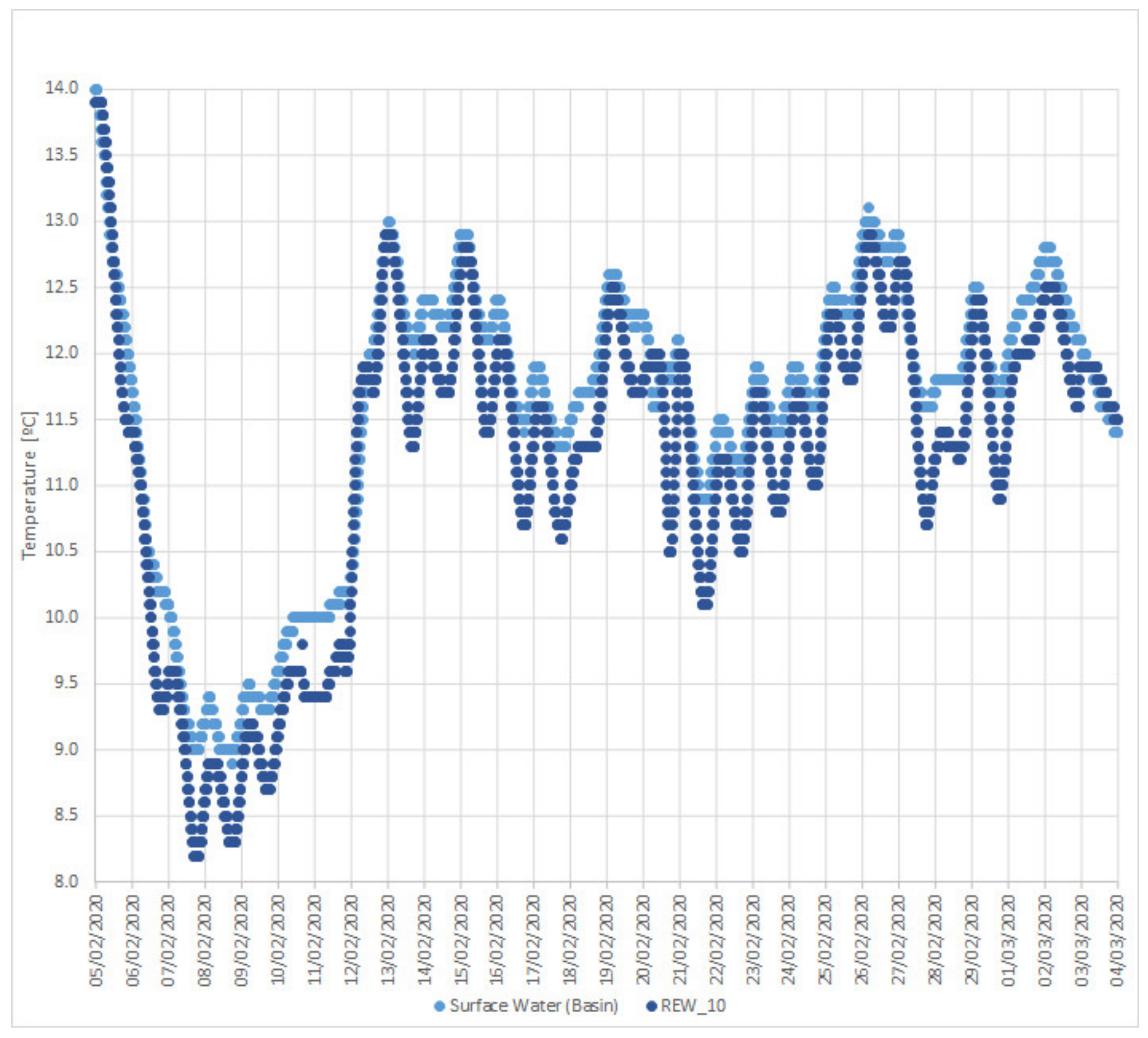
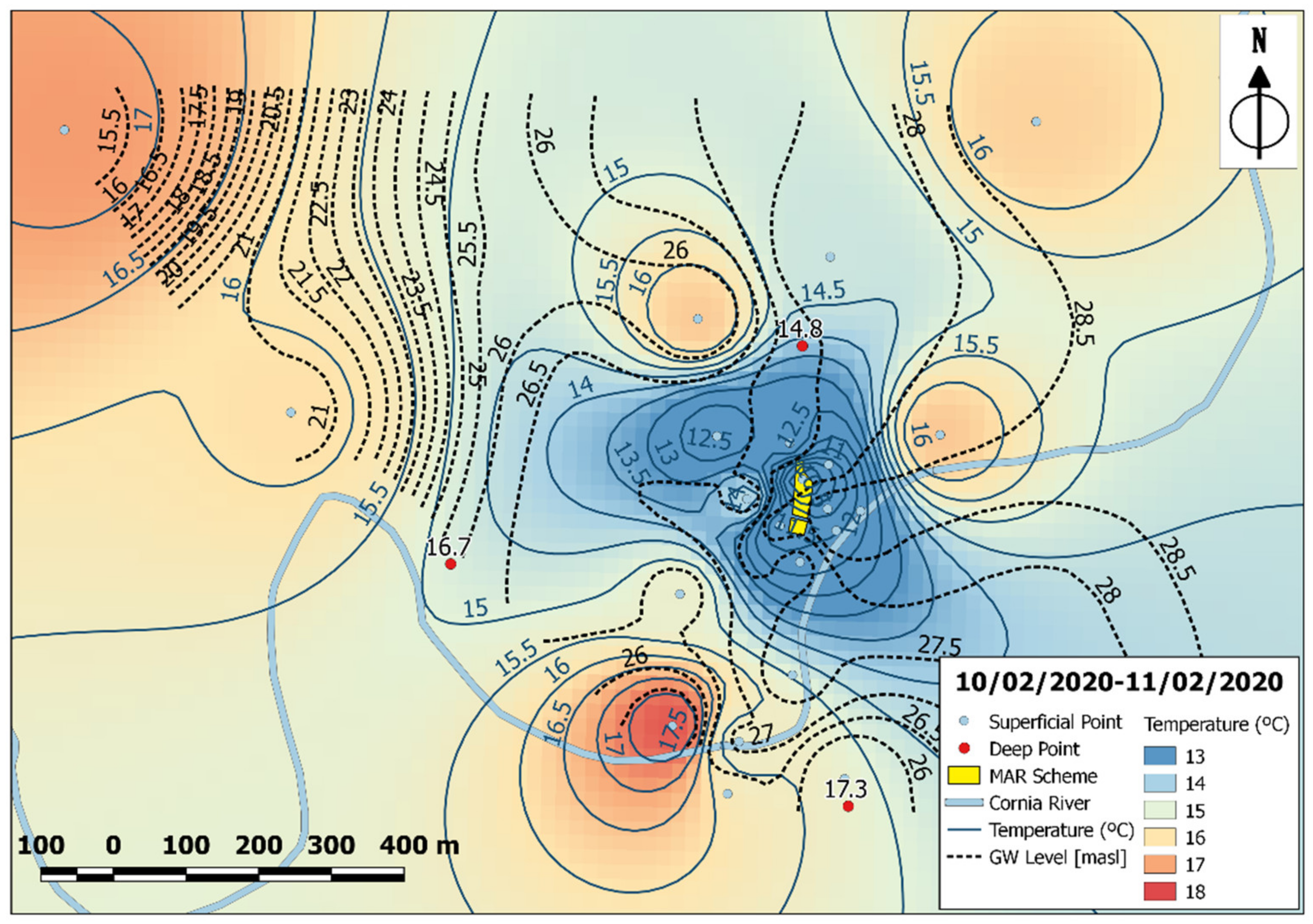

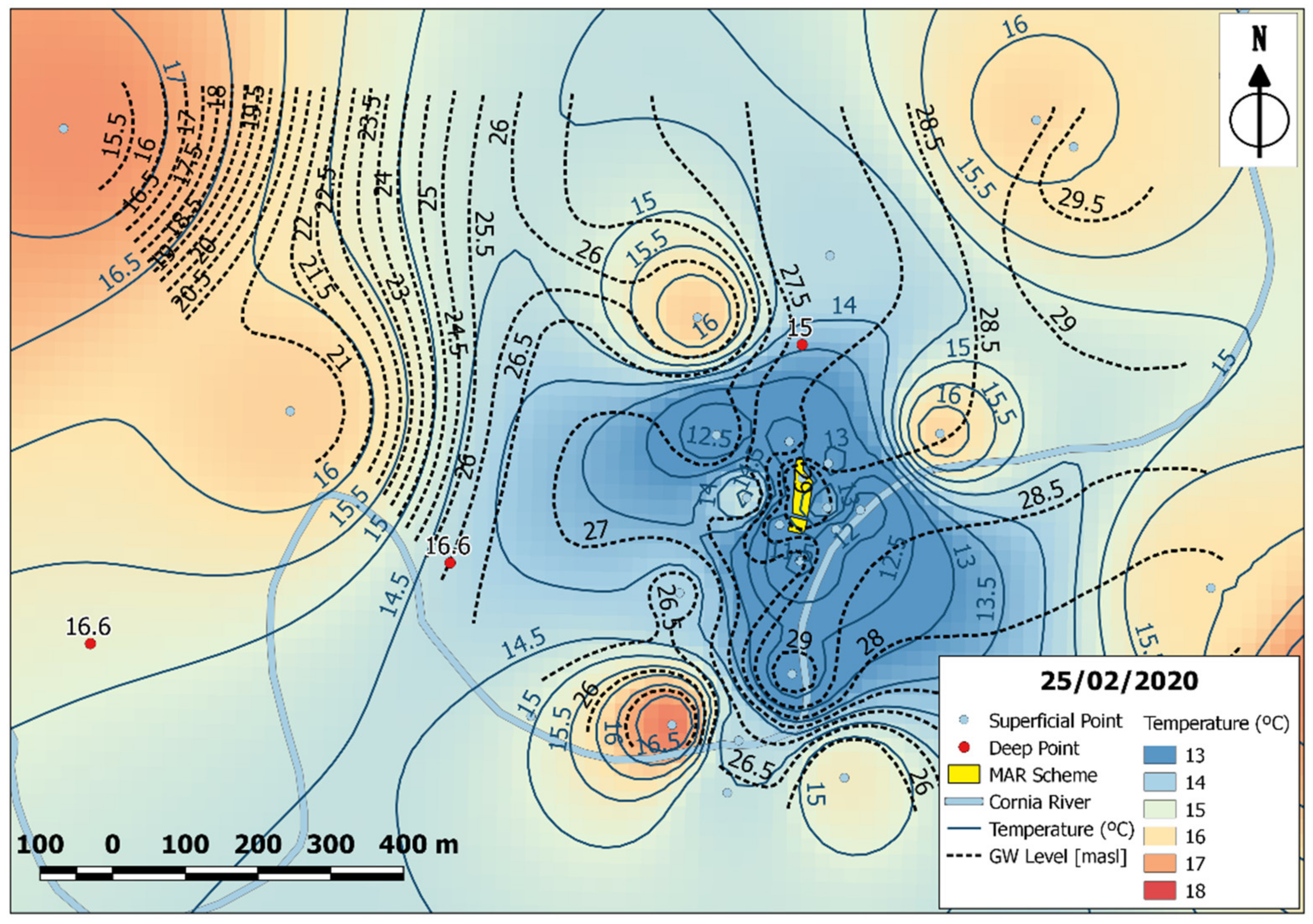
| Point | Piezometer Type | Monitored Depth [m] | Point Depth [m] | Point | Type | Monitored Depth [m] | Point Depth [m] |
|---|---|---|---|---|---|---|---|
| REW_10 | Superficial | 2.70 | 2.80 | REW_39 | Superficial | 15.00 | 15.50 |
| REW_11 | Superficial | 5.00 | 6.14 | REW_3 | Superficial | 10.00 | 12.00 |
| REW_12 | Superficial | 8.00 | 11.84 | REW_5 | Superficial | 5.90 | 6.00 |
| REW_13 | Superficial | 6.00 | 6.50 | REW_6 | Deep | 10.00 | 30.00 |
| REW_14 | Superficial | 6.15 | 6.23 | REW_119 | Superficial | 10.00 | 12.00 |
| REW_15 | Superficial | 6.10 | 6.25 | REW_142 | Deep | 40.00 | 43.00 |
| REW_16 | Superficial | 4.90 | 5.00 | REW_156 | Superficial | 3.90 | 4.00 |
| REW_17 | Superficial | 6.00 | 7.05 | REW_157 | Superficial | 5.50 | 5.60 |
| REW_18 | Superficial | 6.80 | 6.90 | REW_158 | Superficial | 5.20 | 5.25 |
| REW_19 | Superficial | 8.50 | 8.88 | REW_301 | Superficial | 2.00 | 3.76 |
| REW_20 | Superficial | 14.60 | 14.70 | REW_302 | Superficial | 1.60 | 2.88 |
| REW_23 | Superficial | 13.00 | 14.00 | REW_304 | Superficial | 1.50 | 3.71 |
| REW_24 | Superficial | 8.00 | 8.16 | REW_305 | Superficial | 4.00 | 4.94 |
| REW_25 | Superficial | 7.00 | 7.57 | REW_306 | Superficial | 4.10 | 4.15 |
| REW_30 | Superficial | 10.00 | 12.00 | REW_444 | Deep | 20.00 | 30.00 |
| REW_36 | Deep | 21.00 | 30.00 | - | - | - | - |
Publisher’s Note: MDPI stays neutral with regard to jurisdictional claims in published maps and institutional affiliations. |
© 2022 by the authors. Licensee MDPI, Basel, Switzerland. This article is an open access article distributed under the terms and conditions of the Creative Commons Attribution (CC BY) license (https://creativecommons.org/licenses/by/4.0/).
Share and Cite
Caligaris, E.; Agostini, M.; Rossetto, R. Using Heat as a Tracer to Detect the Development of the Recharge Bulb in Managed Aquifer Recharge Schemes. Hydrology 2022, 9, 14. https://doi.org/10.3390/hydrology9010014
Caligaris E, Agostini M, Rossetto R. Using Heat as a Tracer to Detect the Development of the Recharge Bulb in Managed Aquifer Recharge Schemes. Hydrology. 2022; 9(1):14. https://doi.org/10.3390/hydrology9010014
Chicago/Turabian StyleCaligaris, Esteban, Margherita Agostini, and Rudy Rossetto. 2022. "Using Heat as a Tracer to Detect the Development of the Recharge Bulb in Managed Aquifer Recharge Schemes" Hydrology 9, no. 1: 14. https://doi.org/10.3390/hydrology9010014
APA StyleCaligaris, E., Agostini, M., & Rossetto, R. (2022). Using Heat as a Tracer to Detect the Development of the Recharge Bulb in Managed Aquifer Recharge Schemes. Hydrology, 9(1), 14. https://doi.org/10.3390/hydrology9010014






